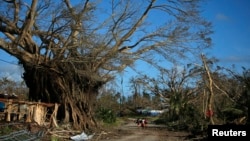Aid workers, who are finally reaching remote areas of Vanuatu ravaged by a cyclone Saturday, said residents face food shortages amid the massive destruction.
Relief agencies said poor weather, limited communications and the geography of a country made up of more than 80 islands are making it difficult to assess damage and reach many of the outlying islands, which were pummeled by Cyclone Pam's gusts of more than 300 kph (185 mph) on Friday and Saturday.
The United Nations humanitarian agency said 11 people are confirmed dead, downgrading its earlier total of 24, but officials expect that number will rise once they reach the more remote islands of Vanuatu. Officials fear that disease and a lack of clean water could add to the current death toll.
Another 3,300 people were sheltering in evacuation centers.
Vanuatu Prime Minister Joe Natuman said it would be at least a week before authorities had a better sense of the destruction.
Tanna island
With communications cut off and reconnaissance flights revealing destroyed houses, shredded forests and damaged buildings, international aid agencies had been particularly worried about Tanna, which bore the full force of the storm.
Residents, who sheltered in schools, churches and other sturdy buildings, told aid workers they were running out of food and basic supplies Tuesday.
Ropate Vuso, 67, told Reuters in Tanna township, "We are running short of food, water, shelter and electricity. We have no communications, we are still waiting for the people from parliament, the chief and the president, but still nobody is coming."
Teacher Saimoni Nainoca, 70, a teacher at Tanna's Tafea College, said, “What we need right now is water and shelter. ... The food in the shops will run out in a week. We need international support and we need communications to be restored.”
International aid, including food, water and building materials is arriving in Port Vila, and should get to Tanna and other hard-hit islands within days, relief workers said.
Oxfam's Vanuatu country manager, Colin Collett van Rooyen, said an assessment flight over the island of Erromango, north of Tanna with a population of around 2,000, had revealed huge damage there, too.
“What we have seen is damage in some villages, at the upper range, of 70, 80, 90 percent, one village in particular 100 percent,” van Rooyen said. “These are small villages but massive destruction.”
In Vanuatu capital Port Vila, the clean-up was progressing after trees were uprooted and homes flattened, but there were worries about food scarcity and health after the main local food market was destroyed and the city's hospital severely damaged.
The majority of locals rely on foods sold at the downtown market such as taro, island cabbage, bananas, kumara and yams for their staple diet.
Shops selling tinned food were open and stocked in the capital, but many locals do not have the money to buy them.
“We have water, but the situation is very bad because people don't have local food,” shop owner Colette Calvo said. “All they can eat is food like bananas that they pick up off the ground and they can get sick.”
Benjamin Shing, from President Baldwin Lonsdale's office, told the Australian Broadcasting Corporation that survivors would quickly run out of food, and after the first week, "we'll need to get some rations on the ground."
With crops wiped out, Shing feared the worst for a country that largely relies on subsistence farming, warning "there might be a lot of fatalities."
International aid
Australia, which has already sent five planes with personnel and humanitarian supplies, dispatched another three planes on Tuesday. It also began loading its emergency response ship HMAS Tobruk, which is capable of driving onto beaches, for possible deployment.
A French navy ship was also being sent from nearby New Caledonia, while a U.S Marine Corps-based Humanitarian Assistance and Disaster Relief team was also being made ready, Australian defense officials said.
Australia was also sending a 20-strong emergency medical assistance team of doctors, nurses, paramedics and a pharmacist. They plan to set up a temporary ward in the car park of the damaged Port Vila hospital capable of treating up to 40 patients. Thousands are still staying in shelters overnight, with a 6 p.m.-6 a.m. curfew in place to prevent looting.
On Monday, Lonsdale told The Associated Press, "This is a very devastating cyclone in Vanuatu. I term it as a monster, a monster. It's a setback for the government and for the people of Vanuatu. After all the development that has taken place, all this development has been wiped out."
VOA spoke with Derek Brien who is in Port Vila, the capital city, where he works for the Pacific Institute of Public Policy. He said "everything has been wiped out" and that is "the most frightening thing because most people here rely on their gardens for food." Brien said all the fruit trees and crops have been destroyed.
Vanuatu is an archipelago of some 80 islands located about 2,200 kilometers off the northeast coast of Australia.
Some material for this report came from Reuters, AFP and AP.









